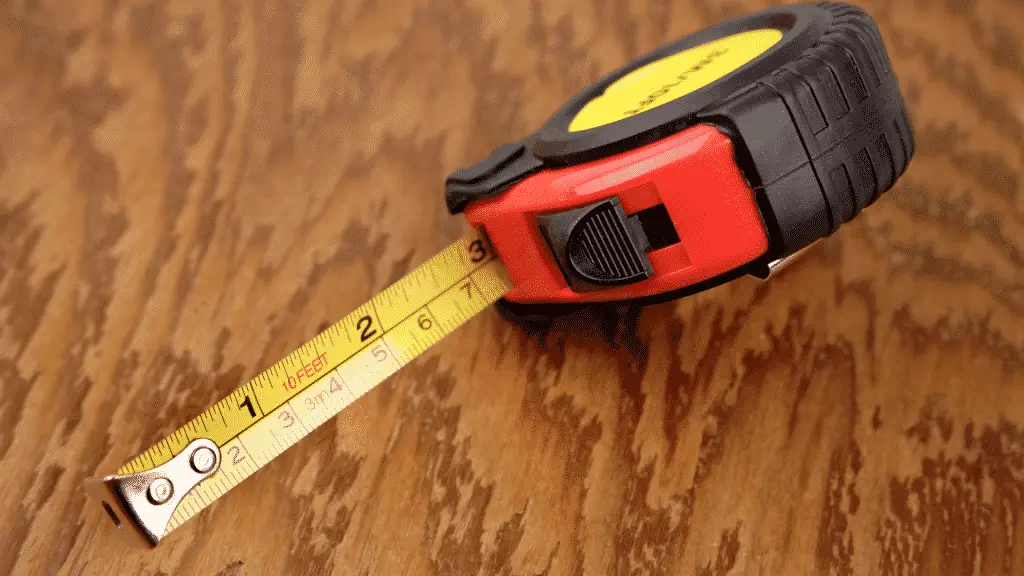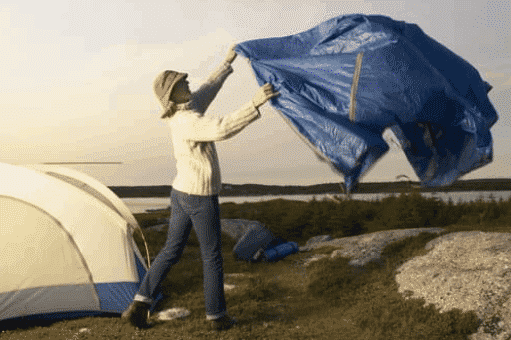Look at some of the tents the next time you go camping at a public campground. Do you see tarps and ground cloths sticking out from the bottom of the tent? If you can see the tent footprint it’s way too big.
How Big Should a Tent Footprint Be? Buy a tent footprint that’s 2″-3″ smaller than the floor of your tent. A footprint that’s bigger than your tent will cause flooding problems in the rain. Water will start to pool on top of the tarp and run underneath the tent causing more harm than good.
Most people don’t realize their tent footprint is a problem until it’s too late. It protects their floor from tears and keeps it clean, but they’ve never tried it out in the rain. Even a light rain can quickly get out of hand with the wrong sized ground cloth.
You might be able to get away with an oversized ground cloth for a while, but it will eventually bite you in the butt. Just do yourself a favor and pick out the right size tent footprint from the start. Don’t wait until it’s too late and your sleeping bag is soaked.
Table Of Contents
What Size Should A Tent Footprint Be?

You need to figure out the size of your tent before you can choose a tent footprint, ground cloth, or tarp. Either measure the inside of your tent floor or look at the product specs of your tent to figure out the overall floor dimensions.
Most manufacturers have release a wide lineup of tents each year so you may have a hard time figuring out the floor size without setting up the tenet. That’s not a problem! All you have to do is stretch the tent on in your yard and start measuring.
Once you’ve measured out the floor, you can start shopping for tent footprints. Finding the right size tent footprint is easy. Just take the floor size and subtract 2-3 inches from the width and length of the tent. The edge of the tent footprint can’t extend outside the outer edges of the tent.
What Size Should A Tent Footprint Be? Tent Footprints Should Be 2-3 Inches Smaller Than The Tent Floor

You really need to figure out the size of your tent before making a purchase. Don’t waste your time with a tent footprint that’s too big. Buy a footprint that’s 2-3 inches smaller than the outside dimensions of your tent.
Think about the surface area of the top of your tent. A basic 3 person tent will cover about 81 square feet. It’s basically like a giant inefficient rain gutter that diverts water around the body of your tent. Since tent footprints are waterproof, all the rain will pool up around the edges of your tent walls.
It doesn’t take a lot of rain to cause pooling issues! All it takes is about 1 inch of rainfall over the surface of your tent to dump 51 gallons of water around the perimeter of your tent. All that water needs to be able to soak into the ground so it won’t pool up around your tent walls.
Check out the US Government Rainfall Calculator to see how much water is diverted around your tent. Even a small 2 person tent
Tent Footprints By Size: Don’t Worry If You Can’t Find The Perfect Tent Footprint Size
After figuring out the size of your tent, it’s time to go shopping for a tent footprint. Some manufacturers have tent footprints specifically designed for their products, but you may have to buy a generic tent footprint.
Thankfully most tents fall into a standard size range based on the amount of people that will be staying inside the tent. They base the floor sizes on the average height of a person and add a few inches of space for gear and longer sleeping pads. Tents might have minor differences in floor dimensions, but it won’t be more than a few inches between manufacturers.
I recommend purchasing either a Redcamp Tent Footprint or Alpine Mountaineering Footprints. They’re affordable and come in most of the standard tent sizes, but you may need to look at generic tent footprints if you have an odd tent size. They’re all basically the same, but there might be a slight weight difference between brands.
You might want to check out Alps Mountaineering’s Website for more sizes. I include the most common sizes in the table below, but they come in like 20 different sizes. So you should be able to find one that works. It doesn’t need to be the perfect size as long as it’s smaller than the tent. A few inches smaller will cut down pack weight so that might actually be preferable.
If that doesn’t work you can always use a tarp as a tent footprint. I explain how to cut down the tarp and install grommets in another post (using a tarp as a tent footprint), but it’s a fairly simple process. All you need is a grommet tool and a pack of grommets. It shouldn’t take longer than 5-10 minutes to make a tarp footprint.
Tent Footprints By Size Chart
| Tent Size | Fold Tarp Down to Size and Use a Grommet Kit to Secure | Tent Footprint Size |
|---|---|---|
| 2-Person | 6×8 Tarp | 7’2″ x4’8″ Footprint |
| 3-Person | 8×10 Tarp | 7’2″ x 6’2″ Footprint |
| 4-Person | 8×10 Tarp | 8’2″ x 7’2″ Footprint |
| 5-Person | 9×12 Tarp | 9’8″ x 7’8″ Footprint |
| 6-Person | 12×16 Tarp | 9’8″ x 9’8″ Footprint |
Ask The Manufacturer For Product Specific Tent Footprints
Call up the manufacturer and ask if they sell a tent footprint designed for your tent. Going with a tent footprint specifically designed for your tent is by far the best option available. You will probably have to pay a premium, but it’s so worth it.
Most manufacturers use standard sizing so their entire lineup can use the same ground cloth. Although there’s no industry standard tent size the chart below should get you pretty close.
It really doesn’t matter if you choose a real tent footprint or tarp as long as it’s the right size for your tent. Just keep in mind that you will most likely have to cut down a tarp and install grommets (my grommet kit). I’m constantly adding grommets to random things, but it will increase the cost of a tarp.
Check Out The Tarps At Harbor Freight

After going to 10+ stores without finding much of anything I stumbled upon a goldmine at Harbor Freight. It’s ridiculous how many different size and style tarps they have.
The entire back wall of my local store was completely covered. If you can’t find a tarp that will work for you at harbor freight, you won’t find one anywhere. You might want to check out their selection online before driving to the store.
Custom Tarps are Way Too Expensive
Don’t even bother trying to find a heavy-duty custom made tarp. Custom tarps are almost exclusively used by truckers, landscapers, construction workers, etc.
A custom tarp for my 3-Person tent would have cost me between $30-$70 depending on its thickness. That’s more expensive than just purchasing the one designed for my tent.
How Thick Should a Tent Footprint Be?
Good luck trying to figure out the thickness of your tent footprint. I tried calling around to a few of the different manufacturers and I couldn’t get a straight answer.
It seems like most ultralight models are .5mm thick and heavy-duty versions are 1.5mm thick. So your footprint should fall somewhere inside that range. Thankfully, it really doesn’t matter how thick your footprint is.
Any newish tarp or ground cloth should work. It just needs to be waterproof and somewhat durable. Don’t go with a ratty old tarp that you find in the garage. It needs to be able to withstand a little bit of pressure without tearing.
Making Your Own Tent Footprint Out of a Tarp
Making a tent footprint is really easy. Follow these steps and watch the video above for more information. I explain this process in detail in another post. Check out my how to use a tent footprint as a tarp post for more information.
- Figure out the size of your tent. You’ll have to set out your tent and measure the bottom if you can’t figure out the size. Just flip the tent upside and spread it out on the floor. You should be able to get a measurement without putting the tent up.
- Choose a tarp that’s 2-3 inches shorter than the length and width of your tent. It’s better to be slightly smaller than too big. If you can’t find a close match you will have to get a big tarp and cut it down.
- Take scissors and cut your tarp down to size. Don’t worry about cutting off grommets they can be added back in later. Save a large piece of the footprint for a later step.
- Adding grommets is optional, but it will sturdy up the tent and give you a place to attach tent poles. Don’t spend a fortune on a grommet kit. A cheap Coghlan’s Grommet kit is all you really need.
- This is an optional step, but I think it’s well worth the hassle. Take the leftover piece of tarp from earlier and cut out four 8-12 inch strips to use as corner grommet straps. Look at the image below as a reference.
- Fold the straps in half and attach them to each corner of your tarp. Just use the grommet kit to attach the strap to your tarp. This should give you good enough connection, but you might want to sew in a few stitches as well.
- Set your tent up over the tarp and figure out where your poles line up with the straps. Install another grommet wherever the tent poles line up and place your poles inside. This should keep your tarp footprint from sliding underneath the tent floor.




